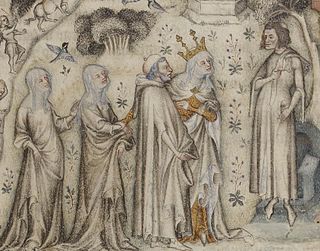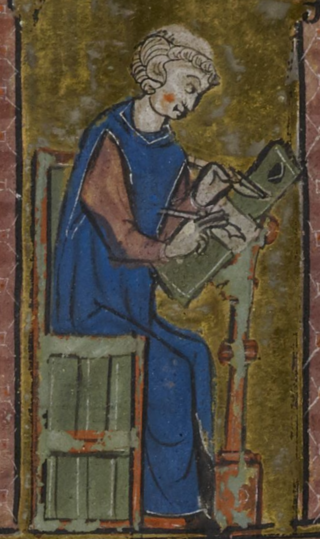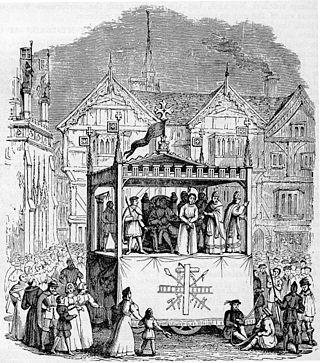Related Research Articles

Guillaume de Machaut was a French composer and poet who was the central figure of the ars nova style in late medieval music. His dominance of the genre is such that modern musicologists use his death to separate the ars nova from the subsequent ars subtilior movement. Regarded as the most significant French composer and poet of the 14th century, he is often seen as the century's leading European composer.

Jehan de Lescurel was a composer-poet of late medieval music. Jehan's extensive surviving oeuvre is an important and rare examples of the formes fixes before the time of Guillaume de Machaut; it consists of 34 works: 20 ballades, 12 rondeaus and two long narrative poems, diz entés. All but one of his compositions is monophonic, representing the end of the trouvère tradition and the beginning of the polyphonic ars nova style centered around the formes fixes.

Adam de la Halle was a French poet-composer trouvère. Among the few medieval composers to write both monophonic and polyphonic music, in this respect he has been considered both a conservative and progressive composer, resulting in a complex legacy: he cultivated admired representatives of older trouvère genres, but also experimented with newer dramatic works. Adam represented the final generation of the trouvère tradition and "has long been regarded as one of the most important musical and literary figures of thirteenth-century Europe".

Medieval French literature is, for the purpose of this article, Medieval literature written in Oïl languages during the period from the eleventh century to the end of the fifteenth century.
France has a rich music history that was already prominent in Europe as far back as the 10th century. French music originated as a unified style in medieval times, focusing around the Notre-Dame school of composers. This group developed the motet, a specific musical composition. Notable in the high Middle Ages were the troubadours and trouvères soon began touring France, composing and performing many original songs. The styles of ars nova and ars subtilior sprung up in the 14th century, both of which focused on secular songs. As Europe moved into the Renaissance age, the music of France evolved in sophistication. The popularity of French music in the rest of Europe declined slightly, yet the popular chanson and the old motet were further developed during this time. The epicenter of French music moved from Paris to Burgundy, as it followed the Burgundian School of composers. During the Baroque period, music was simplified and restricted due to Calvinist influence. The air de cour then became the primary style of French music, as it was secular and preferred by the royal court.
The pastourelle (French:[pastuʁɛl]; also pastorelle, pastorella, or pastorita is a typically Old French lyric form concerning the romance of a shepherdess. In most of the early pastourelles, the poet knight meets a shepherdess who bests him in a battle of wit and who displays general coyness. The narrator usually has sexual relations, either consensual or rape, with the shepherdess, and there is a departure or escape. Later developments moved toward pastoral poetry by having a shepherd and sometimes a love quarrel. The form originated with the troubadour poets of the 12th century and particularly with the poet Marcabru.

Trouvère, sometimes spelled trouveur, is the Northern French form of the langue d'oc (Occitan) word trobador, the precursor of the modern French word troubadour. Trouvère refers to poet-composers who were roughly contemporary with and influenced by the trobadors, both composing and performing lyric poetry during the High Middle Ages, but while the trobadors composed and performed in Old Occitan, the trouvères used the northern dialects of France. One of the first known trouvère was Chrétien de Troyes and the trouvères continued to flourish until about 1300. Some 2130 trouvère poems have survived; of these, at least two-thirds have melodies.

The War of the Sicilian Vespers, also shortened to the War of the Vespers, was a conflict waged by several medieval European kingdoms over control of Sicily from 1282 to 1302. The war, which started with the revolt of the Sicilian Vespers, was fought over competing dynastic claims to the throne of Sicily and grew to involve the Kingdom of Aragon, Angevin Kingdom of Naples, Kingdom of France, and the papacy.

Medieval theatre encompasses theatrical performance in the period between the fall of the Western Roman Empire in the 5th century and the beginning of the Renaissance in approximately the 15th century. The category of "medieval theatre" is vast, covering dramatic performance in Europe over a thousand-year period. A broad spectrum of genres needs to be considered, including mystery plays, morality plays, farces and masques. The themes were almost always religious. The most famous examples are the English cycle dramas, the York Mystery Plays, the Chester Mystery Plays, the Wakefield Mystery Plays, and the N-Town Plays, as well as the morality play known as Everyman. One of the first surviving secular plays in English is The Interlude of the Student and the Girl.
Sylvia Huot is a professor of Medieval French Literature at the University of Cambridge and fellow of Pembroke College. She is the author of several internationally renowned books on Medieval French Literature and the leading expert on the manuscripts of Roman de la Rose, having published extensively on its iconography.
Jehan Erart (or Erars) (c.1200/10–1258/9) was a trouvère from Arras, particularly noted for his favouring the pastourelle genre. He has left behind eleven pastourelles, ten grand chants, and one serventois.

The jeu-parti is a genre of French lyric poetry composed between two trouvères. It is a cognate of the Occitan partimen. In the classic type, one poet poses a dilemma question in the opening stanza, his or her partner picks a side in the second stanza, which replicates the versification of the first and is sung to the same melody. Typically, the jeu-parti has six stanzas, with the two interlocutors alternating stanza by stanza. Many jeux-partis also have final partial stanzas in which one or both of the interlocutors appoint judges and call for judgement. The outcome, however, is virtually never given within the jeu-parti itself and would have been the subject of audience discussion after the jeu-parti's performance. The form was particularly associated with the Puy d'Arras. Over 200 examples survive, of which around 180 are in the classic form.
Chardon de Croisilles or de Reims was an Old French trouvère and possibly an Occitan troubadour. He was probably from Croisilles, but perhaps Reims. He is associated with the school of trouvères in and around Arras. Chardon wrote four chansons d'amour, two jeux partis, and one partimen.
Robert de Castel (d'Arras) was a trouvère active in and around Arras in the late thirteenth century. He is mentioned in the Congés of Baude Fastoul, written in 1272, which place him Arras at that date. He is the addressee of the poem Robert du Chastel, biaus sire, a jeu parti by another trouvère of Arras, Jehan Bretel, which was judged by another Artesian, Gaidifer d'Avion.
Ernoul le Viellede Gastinois was a trouvère of the late thirteenth century. His name may indicate that he was from the Gâtinais, but vielle could mean either "the old" or "the vielle-player".

Julien Tiersot, was a French musicologist, composer and a pioneer in ethnomusicology.

Adam de la Bassée was a canon of the collegiate church of Saint Pierre in Lille, and a poet and musician associated with the circle of trouvères around Arras. Around 1280, he composed the Ludus super Anticlaudianum, a rhyming paraphrase of Alain de Lille's poem Anticlaudianus. The Ludus is conserved in one known manuscript, F-Lm 316 in the Bibliothèque Municipale Jean Levy in Lille, which may be in part a work of Adam's own hand.

Perrin d'Angicourt was a trouvère associated with the group of poets active in and around Arras. His birthplace was most likely Achicourt, just south of Arras. His surviving oeuvre is large by the standards of the trouvères, and well-distributed in the chansonniers: thirty-five (35) of his songs survive, in some case in as many as eleven different manuscripts.

Jean Wauquelin, born in Picardy, was a writer and translator in French, active in the County of Hainaut in the Burgundian Netherlands, a county now located in Belgium near the border with France. Wauquelin died on 7 September 1452 in Mons, Hainaut. His date of birth remains unknown.
Philip de Thaun was the first Anglo-Norman poet. He is the first known poet to write in the Anglo-Norman French vernacular language, rather than Latin. Two poems by him are signed with his name, making his authorship of both clear. A further poem is probably written by him as it bears many writing similarities to his other two poems.
References
- ↑ Hutchinson Encyclopedia (1988), p.10
- 1 2 Dixon, Rebecca; Sinclair, Finn E. (2008). Poetry, Knowledge and Community in Late Medieval France. Boydell & Brewer Ltd. p. 173. ISBN 978-1-84384-177-7 . Retrieved 17 July 2012.
- ↑ Dane, Joseph A. (1985). Res/verba: A Study in Medieval French Drama. Brill Archive. p. 101. ISBN 978-90-04-07424-8 . Retrieved 17 July 2012.
- ↑ Holloway, Julia Bolton (1986). Brunetto Latini: An Analytic Bibliography. DS Brewer. p. 40. ISBN 978-0-7293-0216-6 . Retrieved 17 July 2012.
- ↑ Doss-Quinby, Eglal; Krueger, Roberta L.; Burns, E. Jane (2007). Cultural Performances in Medieval France: Essays in Honor of Nancy Freeman Regalado. DS Brewer. p. 99. ISBN 978-1-84384-112-8 . Retrieved 17 July 2012.
- ↑ Chisholm, Hugh, ed. (1911). . Encyclopædia Britannica . Vol. 01 (11th ed.). Cambridge University Press. p. 171; see lines four and five from the end.
A modern adaptation, by Julien Tiersot, was played at Arras by a company from the Paris Opéra Comique on the occasion of a festival in 1896 in honour of Adam de le Hale